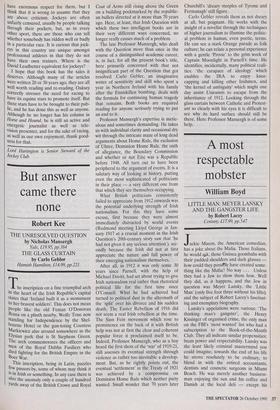But answer came there none
Robert Kee
The inscription on a fine triumphal arch in the heart of the Irish Republic's capital states that 'Ireland built it as a monument to her bravest soldiers'. This does not mean People like the old Fenian O'Donovan Rossa on a plinth nearby, Wolfe Tone now standing for Independence by the Shel- bourne Hotel or the gun-toting Countess Markiewicz also around somewhere in the Elysian park that is St Stephens Green. The arch commemorates the officers and men of the Royal Dublin Fusiliers who died fighting for the British Empire in the Boer War.
This inscription, being in Latin, puzzles few passers-by, some of whom may think it Is in Irish or something. In any case there is also the anomaly only a couple of hundred Yards away of the British Crown and Royal Coat of Arms still rising above the Green on a building pockmarked by the republic- an bullets directed at it more than 70 years ago. Here, at least, that Irish Question with which these two intelligent books are in their very different ways concerned, no longer really causes much of a problem.
The late Professor Mansergh, who dealt with the Question more than once in the course of a distinguished academic career, is, in fact, for all the present book's title, here primarily concerned with that not insignificant part of the Question that got resolved. Carlo Gebler, an imaginative writer of sensitivity and skill who spent a year in Northern Ireland with his family after the Enniskillen bombing, deals with the formula for continuing human tragedy that remains. Both books are required reading for anyone seriously trying to put an end to it.
Professor Mansergh's expertise is metic- ulous and sometimes demanding. He takes us with individual clarity and occasional dry wit through the intricate maze of long dead arguments about Home Rule, the exclusion of Ulster, Dominion Home Rule, the oath of allegiance, the Boundary Commission and whether or not Eire was a Republic before 1948. All turn out to have been peripheral to the argument of events. It is a salutary way of looking at history, putting even the most sophisticated of politicians in their place — a very different one from that which they see themselves occupying.
What British politicians consistently failed to appreciate from 1912 onwards was the potential underlying strength of Irish nationalism. For this they have some excuse, first because they were almost immediately distracted by world events (Redmond meeting Lloyd George in Jan- uary 1917 at a crucial moment in the Irish Question's 20th-century story saw that `he had not given it any serious attention'), sec- ondly because the Irish did not at first appreciate the nature and full power of their emerging nationalism themselves.
After all, in 1912 it was only some 30 years since Parnell, with the help of Michael Davitt, had set about trying to give Irish nationalism real rather than rhetorical political life for the first time since O'Connell. What he had achieved had turned to political dust in the aftermath of the 'split' over his divorce and his sudden death. The Easter Rebellion of 1916 did not seem a real Irish rebellion at the time. The Sinn Fein movement which rose to prominence on the back of it with British help was not at first the clear and coherent popular force it proclaimed itself to be. Indeed, Professor Mansergh, who as a boy heard the first shots of the 'war' of 1919-21, still assesses its eventual strength through violence as rather too inevitable a develop- ment. But, as he rightly points out, the eventual 'settlement' in the Treaty of 1921 was achieved by a compromise on Dominion Home Rule which neither party wanted. Small wonder that 70 years later Churchill's 'dreary steeples of Tyrone and Fermanagh' still figure.
Carlo Gebler reveals them as not dreary at all, but poignant. He works with the insight of a novelist through the techniques of higher journalism to illumine the politic- al problem in human, even poetic, terms. He can see a stark Orange parade as folk culture; he can relate a personal experience with a gentle Provie' to the grim work of Captain Moonlight in Parnell's time. He identifies, incidentally, many political reali- ties: 'the carapace of ideology' which enables the IRA to enjoy knee- capping and killing other Irishmen, and `the kernel of ambiguity' which might one day assist Unionists to escape from the inheritance of 1912. Looking through the glass curtain between Catholic and Protest- ant so clearly with his eyes it is difficult to see why its hard surface should still be there. Here Professor Mansergh is of some help.








































 Previous page
Previous page